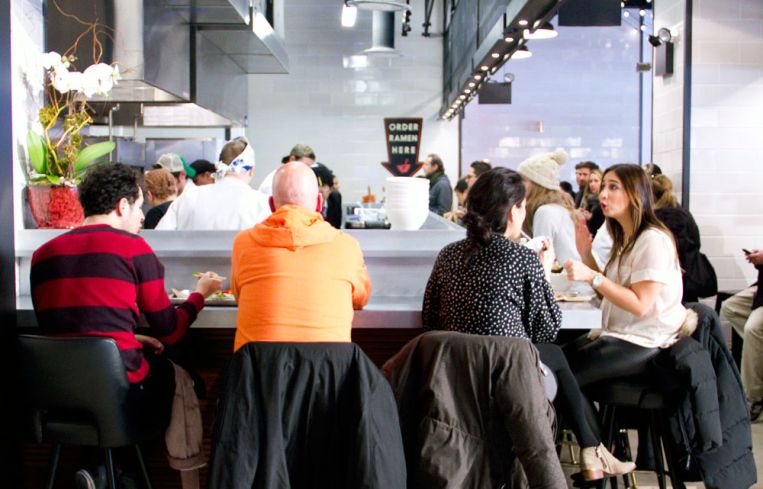Midtown Caters to Hungry Office Workers, Shoppers with Proliferation of Gourmet Food Courts
By Lauren Elkies Schram April 2, 2014 12:00 pm
reprints

Come next spring, Columbus Circle will be home to a 14,750-square-foot food market lined by 10- to 20-foot-wide open storefronts just outside of the busy subway station. On the East Side, Urban Space, the food hall manager behind Mad. Sq. Eats, Broadway Bites and Dekalb Market, recently signed a long-term lease for 10,000 square feet of retail space at the Helmsley Building at 230 Park Avenue. And late last year, Gotham Organization opened Gotham West Market, a 10,000-square-foot Chelsea Market-like food hall in Hell’s Kitchen, to considerable fanfare.
Why are so many food courts—once synonymous with suburban shopping malls and dreary office atriums—not only popping up in Midtown, but luring forward-thinking chefs and adventurous diners?
“The brand recognition and free press associated with being part of a market-type concept also generate a lot of upside for vendors looking to grow,” said Karma McDermott, a partner at SKH Realty, which is working on one food court by the Port Authority Bus Terminal and another one on Madison Avenue by Grand Central Terminal.
Midtown is ideal for food courts because of its daytime population density.
A food court “brings more people in front of the restaurateur, and it’s cheaper [than a proper restaurant],” said Eastern Consolidated’s James Famularo, who has done nearly 600 food-related leases. “They’re like incubators. They [take] people who might work in a kitchen for the next 25 years and give him a stage to start his or her own thing.”
The Lansco Corporation’s Robin Abrams, who is part of the team marketing Turn-Style, the underground concourse at Columbus Circle, said that while that project benefits from being by a transportation hub, the location at the border of Midtown and the Upper West Side is another boon.
“I do believe that there is great synergy with the Time Warner/Columbus Circle project, the office buildings in near proximity, Central Park, the hotels and residential base that bring a huge commercial and residential population to the site,” she said.
A food court allows a brand that may lack the capital to open a full-service operation to set up shop in a more affordable way. At Turn-Style, the rents are $300 to $400 per square foot for five- to 10-year terms, according to the Lansco retail team marketing the space, but the spaces are much smaller—starting at 154 square feet—than if tenants opened stand-alone shops.
“Minimal marketing costs are billed to tenants, as part of additional rent, in many food court or multitenant projects; it’s much less than a tenant doing its own public relations and normally effective,” Ms. Abrams said. “Food court rents may be higher per square foot, but the same or less per unit, as generally [they] are smaller spaces with common areas. [But] for a small highly trafficked space on the street, rent would likely be the same per square foot. For many street stores, the landlord delivers as is, and the tenant does work at its cost.”
Across Midtown at another transportation hub, the Urban Space food hall, which will showcase 20 to 30 chefs and food purveyors, will occupy a space atop Grand Central Terminal, with sidewalk frontage on 45th Street and Vanderbilt Avenue, when it opens early next year.
“We will revive Grand Central Terminal’s fabled dining legacy with a food hall like no other in New York City,” Anthony Westreich, the chief executive officer of Monday Properties, Urban Space’s landlord at 230 Park Avenue, said in a prepared statement.
Food courts speak to the desire for convenience, especially in the lunch-driven Midtown market. And while deli buffets and other quickie options have long abounded, contemporary Midtown food courts offer options normally found in trendier precincts downtown or in Brooklyn.
“What I think is going on is the modern urban food customer wants to have choices,” said Amira Yunis, an executive vice president in the CBRE Retail Group. Ms. Yunis represented Urban Space in the deal at 230 Park. “We’re in a world where customers are used to ordering what they want. … This gives the customers the opportunity to be social and obtain food options in one setting.”
At 230 Park, there will be a non-chef-driven concept rather than a chef-driven one, Ms. Yunis said, declining to elaborate. The space has the advantage of being on a highly visible corner across from Grand Central Terminal. “A lot of this is driven by the location,” she said.
Last November, Gotham West Market opened as a component of the 1,240-unit Gotham West residential rental building at 600 11th Avenue between 44th and 45th Streets. The food ranges from chef Ivan Orkin’s world-renowned ramen to chef Seamus Mullen’s critically acclaimed Spanish tapas. There is an additional 5,000 square feet below grade for food prep and refrigeration, said Chris Jaskiewicz, the president of the marketplace and the developer and chief operating officer of Gotham Organization, the building’s developer. The market is hoping to open a 100-seat sidewalk space this summer.
Mr. Jaskiewicz said his firm wanted to create an “unmatched amenity for our renters” and make it a culinary destination with a disparate collection of chefs. The nine businesses, which include six restaurants, two bars and a bicycle shop, collectively pay $600,000 to $800,000 in annual rent, Mr. Jaskiewicz said. That’s comparable with what the company would have gotten from leasing to a grocery store. The majority of the leases are for five years, with five-year extensions available.
For retailers at Gotham West Market, the perk is “to be part of an unprecedented marketplace and to participate in this venue, which was designed to be different,” Mr. Jaskiewicz said. “They’re part of a great design and an opportunity to work as part of a team to create this destination.” While Gotham has the ultimate right of approval on store signage, the company said it doesn’t interfere with the menus or food preparation.
Arguably the first food court to pave the way for the gourmand trend was the high-end Italian food hall Eataly, located at 200 Fifth Avenue between 23rd and 24th Streets. Opened in 2010 with the participation of longtime Downtown culinary darling Mario Batali, Eataly calls itself a “multifunctional marketplace” and sells Italian delicacies and wine (the wine shop was recently temporarily shuttered after the owners broke liquor laws), a culinary educational center and seven boutique eateries.
“Ever since Eataly opened, the market has showed that food courts no longer had to be unhealthy fast food,” said Mark Birnbaum, a partner at EMM Group, a hospitality management company. “In response to the trend of people being more health-conscious and with more innovative entrepreneurs, chefs and operators, food courts provide an inexpensive platform to show off new culinary skills. Customers are looking for way more than just another Subway.”
Indeed, arriving the same year as Eataly were the Plaza Food Hall by Todd English, which got a boost once the retail was scrapped in favor of food kiosks, and Jeffrey Chodorow’s upscale food court FoodParc, at the Eventi Hotel, at 839 Avenue of the Americas, which has since closed.
Now, there are plans cooking for on-trend food markets in the Financial District, a neighborhood until recently viewed as a culinary Sahara.
First, there’s Brookfield Office Properties’ food hall, Hudson Eats, at lower Manhattan’s Brookfield Place (formerly World Financial Center). That is expected to open to the public next month.
“The appeal to Hudson Eats is that it’s a collection of cult brands in one place, will service an area with extraordinary growth and will offer incredible exposure for each brand,” said Ed Hogan, the national director of retail leasing for Brookfield.
Nearby and opening in 2015, there’s Westfield World Trade Center, which will include a food court in a 350,000-square-foot retail shopping mall at 4 World Trade Center. The space is under construction.
In a similar vein, teen chef Greg Grossman, the executive director at restaurant consultancy Culinaria Group, is working on a gourmet food court-type place, Hudson Food Hall, with the founder of the Manhattan deli chain Bread & Butter. There will be two locations, one on Park Avenue South in the 20s and one on Hudson Street.
Finally, American chef, author and TV personality Anthony Bourdain is working on an international street food market along with entrepreneur Stephen Werther. There were rumors that it could be heading to 4 World Trade Center, butCommercial Observer confirmed that it’s not.
In general, food courts can thrive, Ms. Abrams said, if “the various food tenants offer quality, innovative and, for the most part, healthy food.”
“Food courts are a good opportunity for vendors who are priced out of standalone retail opportunities,” added Ms. McDermott, “especially in Midtown where rents can be in excess of $250 per square foot.”



